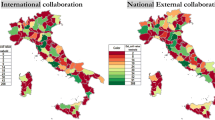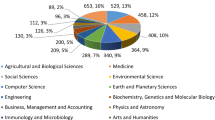Abstract
The objective of our paper is to explore the extent to which the research collaborations could be an impact on the scientific performance of academic institutions. The analysis is based on data for 241 universities in Russia for 2015–2016 obtained from different sources: Interfax (privately held independent major news agency in Russia) National Ranking of Universities, monitoring of efficiency of activity of educational organizations of higher education (launched by Information-Computing Centre of Ministry of Education and Science of the Russian Federation), and Russian Science Citation Index (largest Russian information and analytical portal in science, technology, medicine, and education and electronic library of scientific publications with 28 mlns of documents). We consider the number of citations of publications to evaluate university performance in Russia. To this end, we develop a non-overlapping generation model to evidence the theoretical idea of research externalities between academic institutions. Moreover, we implement different empirical models to test for the effect of external scientific collaborations on the institutional research quality by Federal District and scientific field. The results confirm an important positive impact of co-authoring process.
Similar content being viewed by others
Notes
The first, experimental analysis of the influence of collaboration onto research performance for 50 best Russian universities was performed in the working paper (see Aldieri et al. 2017). The current paper seriously expands this analysis taking into account a wider sample of Russian universities (241 vs. 50) and a more serious span of variables. Improvement of the initial sample of the universities made the econometric analysis results more robust. Expansion of the studied sample and extension of the variables set provided the opportunities for taking into account the geographical effects and effects of the thematic specialization of universities.
See Acemoglu (1996) for a formal proof of Prop. 1.
Thi paper analyses the effects of collaboration on research performance of the best universities for five European countries: Germany, France, Italy, Russia, and UK (the studied sample covers 254 universities).
National Ranking of Universities for 2016 is available on http://univer-rating.ru/rating_common.asp?per=9&p=1. Website is in Russian language.
The official web portal of Monitoring of efficiency of activity of educational organizations of higher education is available here http://indicators.miccedu.ru/monitoring/?m=vpo. Website is in Russian language.
Russian Science Citation Index portal is available on http://elibrary.ru/defaultx.asp. Website is in Russian language.
Fields of science are defined and named by authors
See Cameron and Trivedi (2013) for a technical discussion of Poisson and NB models.
References
Acemoglu, D. A. (1996). Microfoundation for social increasing returns in human capital accumulation. The Quarterly Journal Economics, 111(3), 779–804.
Adams, J. D., Black, G. C., Clemmons, J. R., & Stephan, P. E. (2005). Scientific teams and institutional collaborations: evidence from U.S. universities, 1981-1999. Research Policy, 34, 259–285.
Aldieri, L., & Vinci, C. P. (2017). R&D spillovers and productivity in Italian manufacturing firms. International Journal of Innovation Management, 21(04), 1750035.
Aldieri, L., Kotsemir, M. N., & Vinci, C. P. (2017). The impact of research collaboration on academic performance: an empirical analysis for Russian universities. MPRA Paper No. 76408.
Aldieri, L., Kotsemir, M., & Vinci, C. P. (2018). The impact of research collaboration on academic performance: an empirical analysis for some European countries. Socio-Economic Planning Sciences, 62, 13–30.
Beaver, D. (2001). Reflections on scientific collaboration (and its study): past, present, and future. Feature Report. Scientometrics, 52, 365–377.
Bonaccorsi, A., & Daraio, C. (2005). Exploring size and agglomeration effects on public research productivity. Scientometrics, 63, 87–120.
Bovenberg, L., & Mehlkopf, R. (2014). Optimal design of funded pension schemes. Annual Review of Economics, 6(1), 445–474.
Cameron, A. C., & Trivedi, P. K. (2013). Regression analysis of count data (2nd ed.). Cambridge: Cambridge University Press.
Carillo, M. R., Papagni, E., & Sapio, A. (2013). Do collaborations enhance the high-quality output of scientific institutions? Evidence from the Italian Research Assessment Exercise. Journal of Behavioral and Experimental Economics (formerly The Journal of Socio-Economics), 47(C), 25–36.
Chakravarty, R., & Madaan, D. (2016). SCOPUS reflected study of selected research and higher education institutions (HEIs) of Chandigarh: a city of education and research. Library Hi Tech News, 33(2), 12–14.
Chang, M. J., Wang, P., & Xie, D. (2016). The dynamic process of economic takeoff and industrial transformation. Frontiers of Economics in China, 11(1), 60–87.
Chaudhuri, A., Schotter, A., & Sopher, B. (2009). Talking ourselves to efficiency: coordination in inter-generational minimum effort games with private, almost common and common knowledge of advice. The Economic Journal, 119(534), 91–122.
Chuang, K. Y., & Ho, Y. S. (2015). An evaluation based on highly cited publications in Taiwan. Current Science, 108(5), 933–941.
Cushing, J. M., & Stump, S. M. (2013). Darwinian dynamics of a juvenile-adult model. Mathematical Biosciences and Engineering, 10(4), 1017–1044.
De La Croix, D., & Michel, P. (2002). A theory of economic growth: dynamics and policy in overlapping generations. Cambridge: Cambridge University Press.
Elhorst, J. P., & Zigova, K. (2014). Competition in research activity among economic departments: evidence by negative spatial autocorrelation. Geographical Analysis, 46(2), 104–125.
Fu, J. Y., Zhang, X., Zhao, Y. H., Tong, H. F., Chen, D. Z., & Huang, M. H. (2012). Scientific production and citation impact: a bibliometric analysis in acupuncture over three decades. Scientometrics, 93(3), 1061–1079.
Geracitano, L. A., Chaves, I. S., & Monserrat, J. M. (2009). Scientometric analysis of Latin American environmental studies. International Journal of Environment and Health, 3(4), 427–437.
Gotzen, B., Liebscher, V., & Walcher, S. (2011). On a class of deterministic population models with stochastic foundation. Bulletin of Mathematical Biology, 73(7), 1559–1582.
Goyal, S., Van der Leij, M. J., & Moraga, J. (2006). Economics: an emerging small world. Journal of Political Economy, 114, 403–412.
Graue, M., Iversen, M. M., Sigurdardottir, Á. K., Zoffmann, V., Smide, B., & Leksell, J. (2013). Diabetes research reported by nurses in Nordic countries. European Diabetes Nursing, 10(2), 46–51.
Greene, W. R. (1994). Accounting for excess zeros and sample selection in poisson and binomial regression models. In Working paper 94–10. New York: New York University.
Haagsma, R., & Koning, N. (2005). Endogenous norms and preferencesand the farm income problem. European Review of Agricultural Economics, 32(1), 25–49.
Isiordia-Lachica, P., Rodriguez-Carvajal, R., Angulo, G., Chàvez, K., & Barboza-Flores, M. (2015). Measurement of scientific research performance at the Universidad De Sonora, México. In 2015 Portland International Conference on Management of Engineering and Technology (PICMET) (pp. 204–210). Portland.
John, A., & Pecchenino, R. (1994). An overlapping generations model of growth and the environment. The Economic Journal, 104, 1393–1410.
Katz, S. J., & Martin, B. R. (1997). What is research collaboration? Research Policy, 26, 1–18.
Kodama, H., Watatani, K., & Sengoku, S. (2013). Competency-based assessment of academic interdisciplinary research and implication to university management. Research Evaluation, 22(2), 93–104.
Kotsemir, M., Kuznetsova, T., Nasybulina, E., & Pikalova, A. (2015). Identifying directions for the Russia’s science and technology cooperation. Foresight and STI Governance, 9(4), 54–72.
Maevsky, V. I., Malkov, S. Y., & Rubinstein, A. A. (2016). A theory of overlapping generations of fixed capital. Herald of the Russian Academy of Sciences, 86(1), 39–47.
Marculis, N. G., Lui, R., & Lewis, M. A. (2017). Neutral genetic patterns for expanding populations with nonoverlapping generations. Bulletin of Mathematical Biology, 79(4), 828–852.
Metz, J. A., & Geritz, S. A. (2016). Frequency dependence 3.0: an attempt at codifying the evolutionary ecology perspective. Journal of Mathematical Biology, 72(4), 1011–1037.
Nedorezov, L. V. (2012). Continuous-discrete model of population dynamics with time lag in a reaction of intra-population self-regulative mechanisms. Network Biology, 2(4), 139–147.
Nedorezov, L. V., & Volkova, E. V. (2005). On the impact of winter conditions on the dynamics of a population with non-overlapping generations: a model approach. Zhurnal Obshchei Biologii, 66(6), 484–490.
O’Leary, J. D., Crawford, M. W., Jurczyk, E., & Buchan, A. (2015). Benchmarking bibliometrics in biomedical research: research performance of the University of Toronto’s Faculty of Medicine, 2008–2012. Scientometrics, 105(1), 311–321.
Obamba, M. O., & Mwema, J. K. (2009). Symmetry and asymmetry: new contours, paradigms, and politics in African academic partnerships. Higher Education Policy, 22(3), 349–371.
Olmeda-Gómez, C., Perianes-Rodriguez, A., Antonia Ovalle-Perandones, M., Guerrero-Bote, V. P., & de Moya Anegón, F. (2009). Visualization of scientific co-authorship in Spanish universities: from regionalization to internationalization. ASLIB Proceedings, 61(1), 83–100 Emerald Group Publishing Limited.
Perotti, R. (1993). Political equilibrium, income distribution, and growth. The Review of Economic Studies, 60(4), 755–776.
Riahi, A., Siamian, H., Zareh, A., Navaei, R. A., & Haghshenas, M. R. (2014). Quantitative evaluation of scientific productions in Iran in immunology and microbiology indexed in Scopus database (2000-2012). Journal of Mazandaran University of Medical Sciences, 24(118), 205–213.
Rosenblat, T. S., & Mobius, M. M. (2004). Getting closer or drifting apart? Quarterly Journal of Economics, 119, 971–1009.
Sarabia, M., & Sarabia, J. M. (2007). A Hamiltonian model in non-overlapping generations: family business behavior. International Advances in Economic Research, 13(1), 120–120.
Schotter, A., & Sopher, B. (2006). Trust and trustworthiness in games: an experimental study of intergenerational advice. Experimental Economics, 9(2), 123–145.
Schotter, A., & Sopher, B. (2007). Advice and behavior in intergenerational ultimatum games: an experimental approach. Games and Economic Behavior, 58(2), 365–393.
Sokolov, A., Shashnov, S., Kotsemir, M., & Grebenyuk, A. (2017). Identification of priorities for S&T Cooperation of BRICS countries. International Organisations Research Journal, 12(4), 32–67.
Stein, D. J., Daniels, W., Emsley, R., Harvey, B., Blackburn, J., Carey, P., Ellis, G., Illing, N., Flisher, A., Moolman-Smook, H., & Mwaba, K. (2006). A brain-behaviour initiative for South Africa: the time is right. Metabolic Brain Disease, 21(2–3), 266–271.
Storesletten, K., Telmer, C. I., & Yaron, A. (2007). Asset pricing with idiosyncratic risk and overlapping generations. Review of Economic Dynamics, 10(4), 519–548.
Sweileh, W. M., Shraim, N. Y., Sa’ed, H. Z., & Al-Jabi, S. W. (2016). Worldwide research productivity on tramadol: a bibliometric analysis. Springerplus, 5(1), 1–8.
Terry, A. J. (2015). A population model with birth pulses, age structure, and non-overlapping generations. Applied Mathematics and Computation, 271, 400–417.
Weng, Z., Wolc, A., Shen, X., Fernando, R. L., Dekkers, J. C., Arango, J., et al. (2016). Effects of number of training generations on genomic prediction for various traits in a layer chicken population. Genetics Selection Evolution, 48(1), paper No), 22.
Winkelmann, R., & Zimmermann, K. (1995). Recent developments in count data modeling: theory and application. Journal of Economic Surveys, 9(1), 1–24.
Wooldridge, J. M. (2002). Econometric analysis of cross section and panel data. Cambridge, MA: MIT Press.
Zdravkovic, M, Chiwona-Karltun, L., & Zink, E. (2016). Experiences and perceptions of South-South and North-South scientific collaboration of mathematicians, physicists and chemists from five southern African universities. Scientometrics, 108(2), 717–743.
Zucker, L. G., & Darby, M. R. (2001). Capturing technological opportunity via Japan’s star scientists: evidence from Japanese firms’ biotech patents and products. The Journal of Technology Transfer, 26(1–2), 37–58.
Acknowledgements
The authors are grateful to the Editor and three anonymous reviewers whose comments greatly improved the quality of the paper. The results, conclusions, views, and opinions expressed in this manuscript are only attributable to the authors.
Author information
Authors and Affiliations
Corresponding author
Appendix
Appendix
Rights and permissions
About this article
Cite this article
Aldieri, L., Kotsemir, M.N. & Vinci, C.P. The Effects of Collaboration on Research Performance of Universities: an Analysis by Federal District and Scientific Fields in Russia. J Knowl Econ 11, 766–787 (2020). https://doi.org/10.1007/s13132-018-0570-9
Received:
Accepted:
Published:
Issue Date:
DOI: https://doi.org/10.1007/s13132-018-0570-9
Keywords
- Academic institutions
- Research performance
- Research externalities
- Research collaboration
- Russian universities
- University research
- Non-overlapping generation model
- University performance
- Russia




